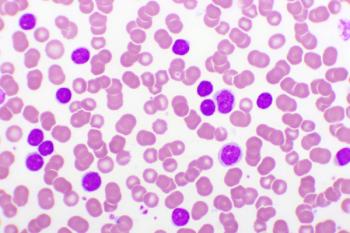
Adding Olaparib and Durvalumab Improved PFS in Patients Newly Diagnosed With Advanced Ovarian Cancer
Interim findings from the DUO-O trial could signal new options for women diagnosed with ovarian cancer at later stages who do not have a BRCA mutation.
Patients newly diagnosed with advanced ovarian cancer without BRCA mutations who received olaparib, a PARP inhibitor, and durvalumab, an immune checkpoint inhibitor, along with standard of care saw improved progression free survival (PFS), according to results being presented today at the American Society of Clinical Oncology (ASCO) Annual Meeting in Chicago.
An interim analysis from the DUO-O study, a phase 3 international randomized clinical trial, show that adding this novel combination improved outcomes compared with standard of care for these patients, who may show no sign of cancer until their disease has progressed.
Despite treatment advances over the past decade, most ovarian cancers are not caught until later stages, and the
The current standard of care for patients who are newly diagnosed with advanced cancer is chemotherapy and bevacizumab. Prior studies of newly diagnosed patients with ovarian cancer, showed success using olaparib in patients with BRCA mutations;
Olaparib currently has
In DUO-O, 1130 patients with stage III or IV high-grade epithelial tumors were randomized into 3 arms. All patients received standard of care, which was paclitaxel/carboplatin chemotherapy plus bevacizumab, followed by maintenance bevacizumab.
In the second 2 arms, patients also received durvalumab, both upfront and in the maintenance phase. Patients in the third arm also received olaparib in the maintenance phase.
Interim results show:
- Investigators found no significant difference in PFS between the control arm and the durvalumab arm (arms 1 and 2).
- PFS increased in patients in the durvalumab plus olaparib arm compared with the standard-of-care arm. Among this group, for HRD-positive patients, PFS was 37.3 months vs 23 months for those in the control arm.
- In the intent-to-treat (ITT) population, PFS was 24.2 months in the durvalumab plus olaparib arm vs 19.3 months for those in the control arm. ITT refers to following all patients in arms they were assigned, regardless of treatment they received; 90% of patients completed the trial.
- Among patients in the durvalumab plus olaparib arm, the risk of the disease progressing was 51% lower in patients with HRD-positive tumors, for a hazard ratio (HR) of 0.49 (95% CI 0.34-0.69; P < .0001) and 37% lower for the intent-to-treat patients, compared with the control arm, for HR 0.63 (95% CI 0.52-0.76; P < .0001).
- The risk of disease progression was 32% lower in all subgroups, including both HRD-positive and HRD-negative patients, compared with the control arm (HR 0.68, 95% CI 0.54-0.86).
- Serious adverse events were reported in 34% of the control arm, 43% in the durvalumab arm, and 39% in the durvalumab plus olaparib arm.
“While there has been significant progress for patients with advanced ovarian cancer, an unmet need still remains,” Philipp Harter, MD, PhD, director in the Department of Gynecology and Gynecologic Oncology at the Evangelische Kliniken Essen-Mitte hospital in Essen, Germany, said in a statement from ASCO. "Our trial results provide encouraging evidence that we can find new treatment approaches for patients with advanced disease."
Investigators noted that additional findings, including overall survival, will be presented as the study progresses.
Data from Cancer.Net show that in 2023, an
Commentator Merry Jennifer Markham, MD, FASCO, of the University of Florida, emphasized the need for more treatment options given the lack of early detection methods for ovarian cancer. In a press briefing, she noted that women who do not have a BRCA mutation are sometimes “disappointed” because until now this has limited their choices of therapy.
“While more research is needed, this trial’s finding that a novel combination of therapies can prolong progression-free survival is indeed promising for patients with advanced ovarian cancer,” she said.
Reference
Harter P, Trillsch F, Okamoto A, et al. Durvalumab with paclitaxel/carboplatin (PC) and bevacizumab (bev), followed by maintenance durvalumab, bev, and olaparib in patients (pts) with newly diagnosed advanced ovarian cancer (AOC) without a tumor BRCA1/2 mutation (non-tBRCAm): Results from the randomized, placebo (pbo)-controlled phase III DUO-O trial. Presented at: American Society of Clinical Oncology; June 2-6, 2023; Chicago, IL. Abstract
Newsletter
Stay ahead of policy, cost, and value—subscribe to AJMC for expert insights at the intersection of clinical care and health economics.









































